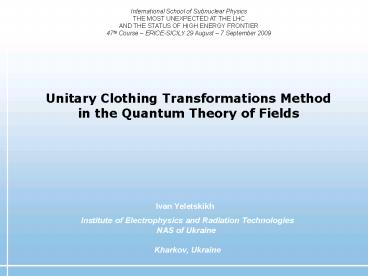Unitary Clothing Transformations Method - PowerPoint PPT Presentation
1 / 15
Title:
Unitary Clothing Transformations Method
Description:
THE MOST UNEXPECTED AT THE LHC. AND THE STATUS OF HIGH ENERGY FRONTIER ... Subtractive renormalization. One possible solution of the problem is to ... – PowerPoint PPT presentation
Number of Views:111
Avg rating:3.0/5.0
Title: Unitary Clothing Transformations Method
1
International School of Subnuclear Physics THE
MOST UNEXPECTED AT THE LHC AND THE STATUS OF HIGH
ENERGY FRONTIER 47th Course ERICE-SICILY 29
August 7 September 2009
Unitary Clothing Transformations Method in the
Quantum Theory of Fields
Ivan Yeletskikh
Institute of Electrophysics and Radiation
Technologies NAS of Ukraine Kharkov, Ukraine
2
Brief reminder
By definition
The S-operator contains all information about all
processes in the system
The Hamiltonian itself is the generator for time
translations
Ivan Yeletskikh Institute of Electrophysics
and Radiation Technologies, Kharkov, Ukraine
Erice, 2009
3
e.g., 3-linear interaction
The Background
Hamiltonian
Interaction V produces unphysical properties
of quanta
in the act of V particles can not simultaneously
stay on their 4-momentum shells
Particles originally involved in theory are
unphysical ( bare )
divergent masses and couplings
self-interactions, persistent cloud effects
Divergent Hamiltonian and S-matrix
Ivan Yeletskikh Institute of Electrophysics
and Radiation Technologies, Kharkov, Ukraine
Erice, 2009
4
Subtractive renormalization
One possible solution of the problem is to add to
the Hamiltonian a set of infinite counterterms,
so as to compensate the divergences in the
S-operator
However, this simply shifts the problem from
S-operator to Hamiltonian.
Hamiltonian, containing infinite counterterms Is
completely unsuitable for describing
the Time-evolution of the system.
Alright Ruth. I about got this one renormalized
Picture is taken from the report of Gabriel
Gonzales Sprinberg, 2003
Ivan Yeletskikh Institute of Electrophysics
and Radiation Technologies, Kharkov, Ukraine
Erice, 2009
5
To solve the above mention problems, a brilliant
idea was proposed by Greenberg and Schweber
(1958).
The idea consists in reformulating the theory in
terms of clothed quanta, that have observable
properties
W operator of unitary clothing transformation
It is important that
The Hamiltonian operator, redefined in terms of
clothed particle operators is the same
Hamiltonian.
The divergences and self-interaction effects are
accumulated in new particle operators
6
There is a broad class of unitary transformations
that can carry different tasks
7
We start form the representation of bare
particles with physical masses
Transformed Hamiltonian acquires the form of
infinite series of multiple commutators
To ensure the physical properties of the new
quanta, we have to achieve the property
new one-particle states is the eigenstates of
total Hamiltonian
8
(1)
New interaction must preserve clothed
one-particle states and clothed vacuum
(2)
Bad operators are the operators with empty
energy shell
9
The Outcome
The generator of clothing transformation is
determined order by order in interaction
The Hamiltonian acquires the sparse Structure in
the Fock space of clothed particle states
Shirokov, Shebeko, Korchin, Korda, Canton,
Frolov, Dubovik, Yeletskikh (2001 2009)
The Unitary Clothing Transformation Method was
applied to the field theoretical models of
mesodynamics
10
The nucleon mass shift in the model of vector
mesodynamics
Directions of arrows distinguish nucleons from
antinucleons
are the observable masses of nucleons and mesons
correspondingly
The lowest-order contribution to the nucleon
mass-shift
This expression is a 3-dimentional representation
of the corresponding result that could be
derived from the Dyson-Feynman perturbation
series. So, actually, this is a checking-out
results.
11
There are six machanisms of the vertex clothing
in the third-order in interaction, stemming from
the third-order commutator
in the Hamiltonian
Each of these operators is defined off the
energy shell and in fact contains three
contributions
12
Each (of six) mechanisms of vertex clothing
consists of three contributions that Illustrate,
how the off-energy structures contribute to the
vertex formfactor
In each punctured vertex energy conservation
law does not hold
In fact, due to this machanism, the
off-energy-shell structures enter all the
operators of physical interactions in
the Hamiltonian operator
If we calculate all the contributons to the
vertex clothing we obtain the final
formfactor, which determines the three- linear
interaction vertex between clothed quanta
13
One should stress, that the theory of clothted
particles are non-local in the field theoretical
sense. The clothed-particle Hamiltonian, in fact,
could not be expressed through the quantum local
fields.
Being put on the energy shell, the vertex
formfactor can be brought to the explicitly
covariant form, which gives a 3-dimentional
representation of the Dyson-Feynman result for a
charge Renormalization contribution in the third
order I perturbation
E.g., in the scalar Yukawa model, the result for
the charge shift is the following
,
14
The Family of Relativistic interactions
The family of interactions between clothed
particles
The model of mesodynamics
Final hamiltonian does not contain any
renorm-terms, and any
interaction operators with empty energy shell
(bad operators)
15
The Prospects and Questions































